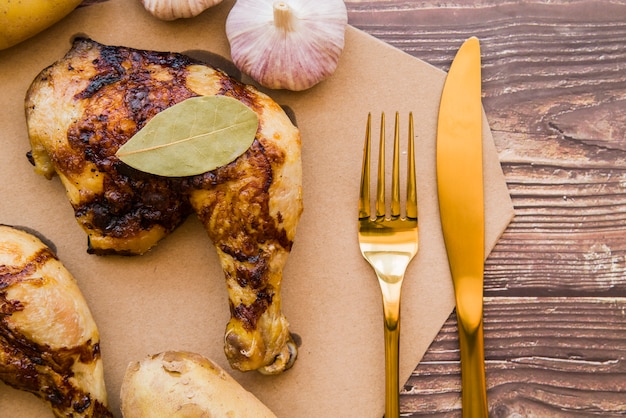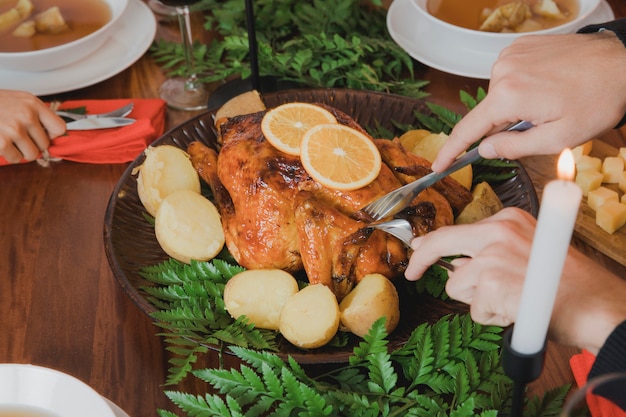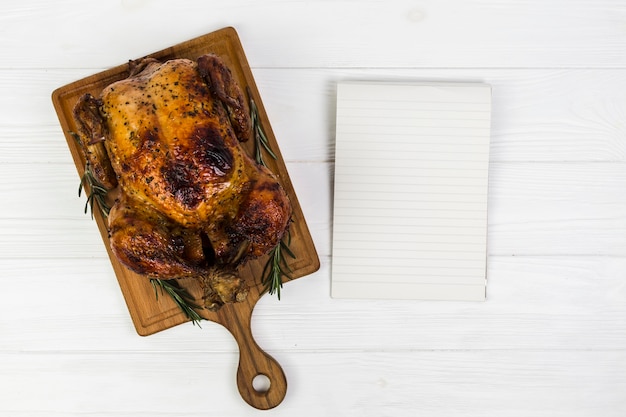Let's be honest, there's nothing quite like the smell of a perfectly roasted chicken wafting through the kitchen. The crispy skin, the juicy meat, the irresistible aroma – it's a culinary masterpiece! But, you know what's more satisfying? Nailing that rotisserie chicken every single time. No more guessing, no more dry, overcooked birds, just pure, succulent goodness.
I've been a long-time fan of rotisserie cooking, and I've learned a thing or two along the way. Whether you're a seasoned pro or a rotisserie newbie, this guide is packed with tips, tricks, and insights to make your next chicken roast a showstopper.
(Part 1) The Science Behind Rotisserie Cooking

Before we dive into timings and recipes, let's talk about the magic behind this whole rotisserie thing. It's not just about throwing a chicken on a stick and hoping for the best. It's a carefully orchestrated dance between heat, rotation, and time, all working together to create that perfect roast.
The Rotisserie Revolution: Even Cooking and Crispy Skin
Imagine a slow, gentle dance. That's what your chicken does on the rotisserie – a continuous, even rotation that ensures every part gets kissed by the heat. No more dry breasts, no more burnt legs, just a symphony of perfectly cooked chicken. This rotational magic also creates that irresistible crispy skin. The constant movement allows the fat to render out, creating a golden-brown, crackly exterior that's both beautiful and delicious.
Understanding Rotisserie Heat and cooking times: Finding the Sweet Spot
Now, you can't just throw any old chicken into any old oven and expect perfection. There's a science to it! The temperature of your oven plays a crucial role. Too low, and your chicken will be taking a nap in there for hours. Too high, and you'll end up with a charred exterior and a raw center – not the ideal outcome! The sweet spot lies somewhere between 350°F and 400°F.
(Part 2) Determining the Right Cooking Time for Your Chicken: A Guide to Golden Ratios

Now for the million-dollar question: how long do I cook this thing? There's no one-size-fits-all answer, but I'll give you the tools to calculate the perfect cooking time for your bird.
Cooking Time Guidelines: A Starting Point for Perfection
Here's a handy table with general cooking times based on chicken weight. Remember, these are just starting points – adjust based on your specific rotisserie and oven.
| Chicken Weight (lbs) | Cooking Time (Minutes) |
|---|---|
| 2-3 | 60-75 |
| 3-4 | 75-90 |
| 4-5 | 90-105 |
| 5-6 | 105-120 |
The meat thermometer: Your Secret Weapon for Rotisserie Success
Don't be fooled by the alluring golden hue of the skin. A meat thermometer is your best friend in the rotisserie game. It's the only way to guarantee that your chicken is cooked to perfection. Aim for an internal temperature of 165°F in the thickest part of the thigh, avoiding the bone.
(Part 3) Rotisserie chicken recipes: A Feast for the Senses

Now for the fun part – flavor! Rotisserie chicken is a blank canvas for culinary creativity. Whether you're keeping it classic with herbs or venturing into bold new territories, there's a recipe out there for every taste.
1. Classic Herb Roasted Chicken: The Simplicity of Flavor
Sometimes, the simplest things are the best. A blend of dried herbs like rosemary, thyme, and oregano, rubbed all over the chicken, creates a symphony of aromas. Season generously with salt and pepper, and maybe add a touch of garlic powder or paprika for a hint of depth.
2. Lemon and Herb Chicken: A Citrusy Delight
For a burst of brightness, try a lemon and herb marinade. A combination of lemon juice, olive oil, fresh herbs like parsley and dill, garlic, and a pinch of salt and pepper will transform your chicken into a citrusy masterpiece. Marinate for at least an hour, letting the flavors penetrate the meat.
3. Spicy Chipotle Chicken: A Smoky Kick
Feeling adventurous? Dive into a world of smoky, spicy flavors with a chipotle marinade. Mix adobo sauce from canned chipotle peppers in adobo sauce with garlic, cumin, paprika, and a touch of brown sugar. The result is a rich, smoky, and slightly sweet glaze that will tantalize your taste buds.
4. Honey Garlic Chicken: Sweet and Savory Harmony
For a sweet and savory symphony, create a honey garlic glaze. Whisk together honey, soy sauce, garlic, ginger, and a hint of sesame oil. Baste your chicken with this glaze during the last 30 minutes of cooking. The result? A sticky, caramelized finish that's irresistible.
(Part 4) Rotisserie Chicken Tips and Tricks: Elevate Your Roast
Now that you have the basics down, let's level up your rotisserie game with a few tips and tricks.
1. Brining Your Chicken: The Secret to Juicy Perfection
Brining is a game-changer. It's a magical process that involves soaking the chicken in a salt-water solution. The salt draws moisture out of the chicken and then back in, creating a more tender, juicy, and flavorful bird. To brine, simply mix salt, sugar, and water. Submerge the chicken in the brine for at least 4 hours, or up to overnight.
2. Using a Rotisserie Basket: Keeping Your Chicken in Check
A rotisserie basket is a handy tool that keeps your chicken from spinning too fast. This leads to more even cooking and less splatter, ensuring a perfectly roasted bird. It also helps prevent the chicken from getting stuck on the spit, which can be a frustrating experience.
3. Adding Vegetables to the Rotisserie: A Complete Meal in One
Why stop at just chicken? Place some vegetables around the chicken on the rotisserie – think potatoes, carrots, and onions. As they roast alongside the chicken, they'll soak up the delicious drippings, creating a flavorful side dish that complements the main attraction.
4. Making Rotisserie Chicken Stock: Don't Waste Those Drippings!
Don't throw away those golden drippings! They're packed with flavor and can be transformed into a delicious stock. Deglaze the pan with a little wine or water, scrape up the browned bits, and simmer with some vegetables for a rich and flavorful broth that will elevate your soups, stews, and sauces.
(Part 5) Rotisserie Chicken: Beyond the Roast
The magic of rotisserie chicken doesn't end with the roast itself. It's a versatile ingredient that can be used in countless ways, making it a true culinary chameleon.
1. chicken salad Sandwiches: A Classic with a Twist
Shred the chicken and mix it with mayonnaise, celery, onion, and your favorite seasonings. Serve on toasted bread for a delicious and easy lunch or dinner.
2. chicken tacos: A Flavor Explosion in Every Bite
Slice the chicken and toss it with your favorite taco toppings like salsa, sour cream, and shredded cheese. Serve in warm tortillas for a quick and tasty meal that's perfect for a weeknight dinner or a fun gathering.
3. chicken noodle soup: A Warm and Comforting Classic
Shred the chicken and add it to a pot of homemade chicken noodle soup for a hearty and comforting meal that's perfect for chilly days.
4. Chicken Pizza: A Pizza Night Makeover
Top a pizza crust with rotisserie chicken, mozzarella cheese, and your favorite vegetables for a delicious and easy pizza night. The rotisserie chicken adds a unique flavor and texture to your pizza, making it a step above the ordinary.
(Part 6) Choosing the perfect chicken for Rotisserie Cooking: Finding the Right Bird
You've got your rotisserie ready, your recipes chosen, but now you need the star of the show – the chicken! Choosing the right bird is crucial for a successful roast.
1. Look for a whole chicken: The Ultimate Rotisserie Star
Rotisserie cooking shines when you're working with a whole chicken. It's the perfect size and shape for the rotisserie, and you'll get the most bang for your buck.
2. Check for Skin: The Key to Crispy Perfection
Make sure the chicken has intact skin. This will help keep the moisture in during cooking and create that delicious crispy skin that's the hallmark of a great rotisserie chicken.
3. Avoid frozen chicken: Freshness is Key
While you can technically roast frozen chicken, it's best to use fresh or thawed chicken for optimal results. Frozen chicken may take longer to cook, and the texture might not be as good.
4. Consider Organic: For a Flavorful Upgrade
If you're feeling fancy, try an organic chicken. They often have a more flavorful, delicate taste that enhances the overall experience.
(Part 7) Troubleshooting Rotisserie Cooking: Common Challenges and Solutions
Let's be real, even the most experienced cooks can run into a few hiccups in the kitchen. Here are some common rotisserie cooking challenges and how to overcome them:
1. Dry Chicken: The Enemy of a Perfect Roast
One of the most common rotisserie chicken woes is dry meat. Here are a few ways to prevent it:
- Brine Your Chicken: This is a surefire way to lock in moisture and ensure juicy chicken.
- Don't Overcook: Use a meat thermometer to make sure your chicken is cooked to 165°F. Overcooking can lead to dry, tough meat.
- Use a Rotisserie Basket: A basket helps prevent the chicken from spinning too fast, which can lead to dry meat.
2. Unevenly Cooked Chicken: Ensuring a Consistent Roast
If your chicken isn't cooking evenly, here are a few things you can do:
- Make Sure the Spit is Secure: A loose spit can cause the chicken to spin unevenly.
- Adjust the Rotisserie Position: If the chicken is too close to the heat source, it might cook unevenly. Move it slightly further away if needed.
- Use a Rotisserie Basket: A basket can help ensure more even cooking by preventing the chicken from spinning too fast.
3. Burnt Skin: Achieving a Golden Brown, Not a Charred Exterior
If the skin is getting too burnt before the inside is cooked, try these tips:
- Reduce the Oven Temperature: Lower the oven temperature slightly to prevent the skin from burning too quickly.
- Use a Rotisserie Basket: A basket can help protect the skin from direct heat and prevent burning.
- Cover the Chicken: During the last 15-20 minutes of cooking, you can cover the chicken with foil to prevent the skin from burning.
(Part 8) FAQs: Your Rotisserie Chicken Questions Answered
You've got questions, and I've got answers! Here are some of the most common rotisserie chicken queries and their solutions:
1. Can I Use a Rotisserie on a Gas Grill?
Absolutely! Many gas grills have built-in rotisseries. Just follow the instructions for your specific grill, and get ready to enjoy the smoky flavors of grilling.
2. How Do I Clean a Rotisserie Spit?
After your chicken is done, remove the spit and clean it thoroughly with soapy water. You can use a scrub brush or a sponge to get rid of any stuck-on food or grease.
3. Do I Need a Rotisserie to Cook Chicken?
While a rotisserie is a fantastic way to cook chicken, it's not essential. You can achieve a similar result by roasting the chicken in a regular oven. Just remember that the cooking time might vary, and you might need to adjust your roasting technique slightly.
4. How Do I Know When My Chicken is Done?
The best way to know when your chicken is done is to use a meat thermometer. Insert the thermometer into the thickest part of the thigh (not touching bone). It should register at 165°F.
5. Can I Roast a Whole Turkey on a Rotisserie?
Yes, you can! Just follow the same general cooking guidelines as you would for a chicken, but adjust the time accordingly based on the size of the turkey. Be sure to use a meat thermometer to ensure the turkey is cooked through.
Now, you're armed with the knowledge to create a rotisserie chicken that's not only delicious but also a testament to your culinary skills. So go forth, experiment, and enjoy the journey of roasting perfection!
Everyone is watching

Perfect Rice Every Time: The Ultimate Guide to Cooking Rice
Cooking TipsAs a self-proclaimed foodie, I've always been a bit obsessed with rice. It's the foundation of countless cuisi...

The Ultimate Guide to Cooking Asparagus: Tips, Techniques, and Recipes
Cooking TipsAsparagus. The mere mention of this spring delicacy conjures up images of vibrant green spears, crisp and burs...

Ultimate Guide to Cooking the Perfect Thanksgiving Turkey
Cooking TipsThanksgiving. Just the word conjures up images of overflowing tables laden with delicious food, the scent of r...

Prime Rib Roast Cooking Time Chart: Per Pound Guide
Cooking TipsPrime rib roast. Just the name conjures images of lavish dinners, crackling fires, and hearty laughter. It’s ...

Can You Cook Spaghetti with Gasoline? (The Shocking Truth)
Cooking TipsWe've all seen those crazy internet trends. You know, the ones that make you wonder, "Did someone actually try...
